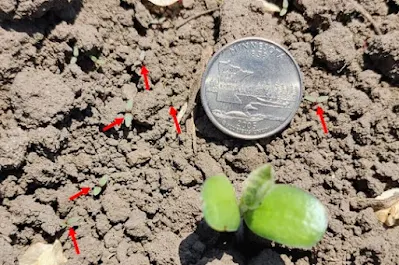Navjot Singh, Graduate research assistant, Debalin Sarangi, Extension weed specialist, Ryan Miller, Extension educator – crops, Tom Peters, Sugarbeet Extension weed specialist, and Seth Naeve, Extension soybean agronomist
Waterhemp (Amaranthus tuberculatus) is a summer annual weed that some of our Minnesota growers' surveys reported as the most difficult-to-control weed in agronomic crops (e.g., corn, soybean, and sugar beet). Waterhemp emerges from May to early August depending on the weather conditions and management practices (Figure 1).
The waterhemp populations were screened for resistance to eight postemergence herbicides in greenhouse facilities at UMN’s Twin Cities campus. The herbicides
were sprayed at the labeled rates (1x) and 3 times the labeled rates (3x) to two separate groups of waterhemp plants from each population. The plants were 4-inches tall at herbicide application. The experiment was repeated twice in the
greenhouse. Herbicide names and labeled rates are included in Table 1.
Table 1. Postemergence herbicide list and rates.
 |
| Fig. 1. Waterhemp (red-arrowed) emerging in a soybean field near Rosemount, MN in late May, 2023. Photo: Debalin Sarangi |
Herbicide resistance screening
Recently, UMN Extension weed specialists received several inquiries about waterhemp control failures in corn, soybean, and sugar beet production in Minnesota (Figure 2). We screened 90 waterhemp populations collected from 47 counties in Minnesota from 2021 to 2023. The putative herbicide-resistant waterhemp seeds were either submitted by the growers, agronomists, or UMN’s Extension Educators, or were collected by the members of the UMN Extension Weed Science group.
 |
| Fig 2. Waterhemp control failure in a soybean field in Renville County, MN. Photo: Debalin Sarangi. |
Table 1. Postemergence herbicide list and rates.
| Herbicide trade name |
Active ingredient |
Site of action group# |
Labeled rate (corn or soybean) |
|---|---|---|---|
| Raptor | imazamox | 2 | 5 fl oz/A |
| Enlist One | 2,4-D choline | 4 | 2 pt/A |
| Xtendimax | dicamba (w/VaporGrip) | 4 | 22 fl oz/A |
| Aatrex | atrazine | 5 | 2 lb ai/A |
| Roundup PowerMax | glyphosate | 9 | 32 fl oz/A |
| Liberty | glufosinate | 10 | 32 fl oz/A |
| Flexstar | fomesafen | 14 | 1 pt/A |
| Callisto | mesotrione | 27 | 3 fl oz/A |
In this study, waterhemp populations exhibiting 40% or more survival at 3x the labeled rate of a herbicide were classified as ‘highly resistant’ to that herbicide. Populations with less than 40% survival at 3x the labeled rate but 40% or more survival at the labeled rate (1x) were classified as ‘moderately resistant’. Populations with 20 to 39% survival at the labeled rate were classified as ‘less sensitive’.
Results
The results indicated that the majority of the waterhemp populations screened in this study were resistant to Roundup PowerMAX (site of action Group 9) and Raptor (Group 2). Thirty-one percent of the populations were also resistant to Flexstar (Group 14). Waterhemp populations resistant to these herbicide sites of action were previously reported in Minnesota, but our experiment demonstrated that resistant populations are spreading rapidly across the state.
Moreover, we observed new cases of herbicide resistance in waterhemp in Minnesota. Forty-seven percent, 22%, and 10% of all populations were resistant to Aatrex (Group 5), Callisto (Group 27), and Enlist One (Group 4), respectively. Two waterhemp populations exhibited tolerance to Xtendimax (Group 4). The herbicide resistance screening results are summarized in Figure 3.
Multiple resistance
Of greater concern, waterhemp populations with multiple herbicide resistance are spreading in Minnesota. A waterhemp population was listed as multiple herbicide-resistant if the same population displayed resistance to two or more herbicide sites of action. Single herbicide resistance can be managed by tank-mixing or rotating herbicides from alternate sites of action.
On the other hand, multiple herbicide resistance substantially reduces the postemergence herbicide choices. Twenty-eight populations were resistant to Raptor and Roundup PowerMAX both, and 34, 16, 7, and 4 populations indicated three-, four-, five-, and six-way resistance, respectively. Two populations from Lincoln and Lyon Counties exhibited resistance to Raptor (Group 2), Enlist One (Group 4), Dicamba (Group 4), Aatrex (Group 5), Roundup PowerMAX (Group 9), Flexstar (Group 14), and Callisto (Group 27). These six-way resistant waterhemp populations (resistant to six herbicide sites of action) left only Liberty for postemergence control of waterhemp in corn and soybean.
Management considerations
This report is aimed at creating awareness among growers, agronomists, and other interested groups regarding the potential threat posed by the herbicide-resistant waterhemp in Minnesota. Please consider the following points regarding waterhemp management in agronomic crops.- Mixing and rotating with effective herbicide sites of action is still recommended.
- Use full rate of herbicides and apply postemergence treatments when weeds are less than 4-inch tall.
- Read herbicide labels for rates, mixing restrictions, application requirements, and other relevant information.
- Start clean and stay clean! – using preemergence herbicides at full rates at planting will keep the field relatively weed-free at the beginning and that will provide some extra time for postemergence weed control.
- Layered residual control of waterhemp is very effective. Research showed that preemergence followed by postemergence herbicide program was superior for waterhemp control than a single-pass program. Tank-mixing soil residual herbicides (e.g., Dual II Magnum, Outlook, Warrant, and Zidua, etc.) with foliar-active postemergence treatment can provide season-long waterhemp control (read Managing waterhemp with layered residual herbicides).
- Scout fields between 7 and 14 days after the postemergence herbicide application to determine treatment effectiveness. Any surviving waterhemp plants should be rouged.
- Diversify your weed management strategy – Integrating cultural and mechanical control tactics with chemical control strategies will improve waterhemp management. Fall-seeded cover crops (e.g., cereal rye) may improve waterhemp control when combined with chemical control strategies. Rotating corn and soybean with small grains or alfalfa helps with waterhemp control and seedbank management.

Comments
Post a Comment